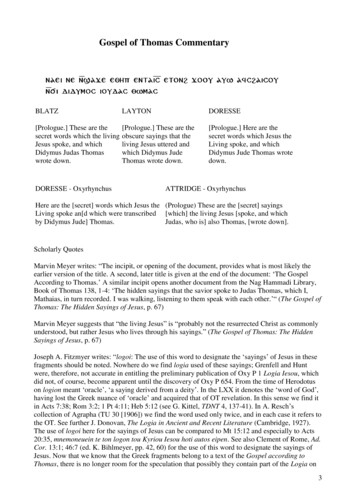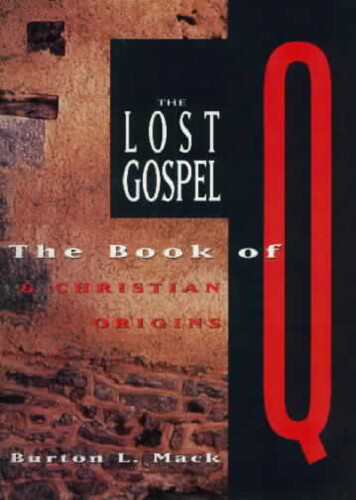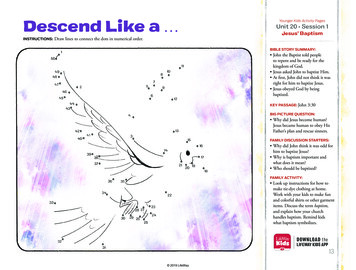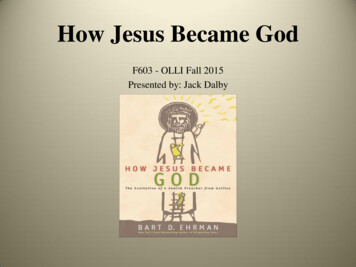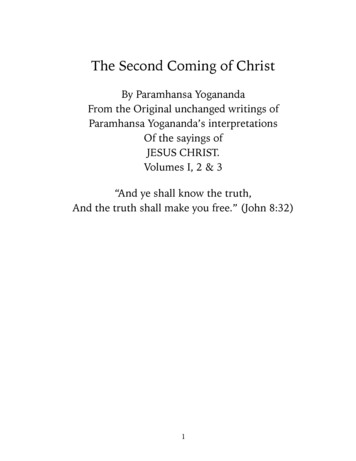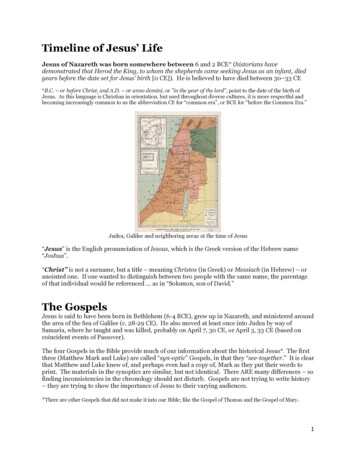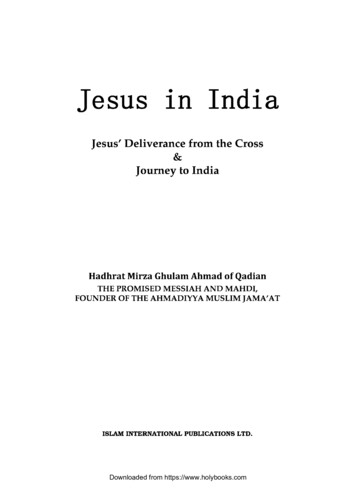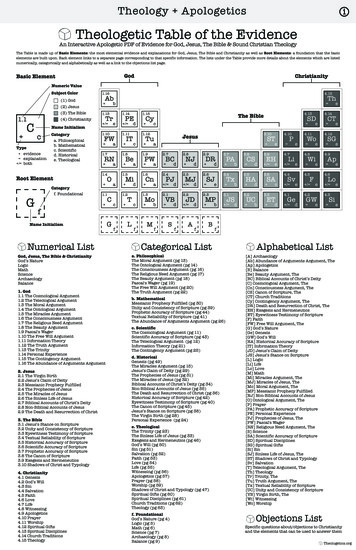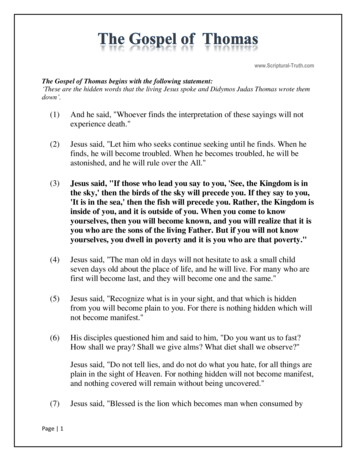
Transcription
EGYPT EXPLORATION FUND CDQRAECO-ROMAN BRANCHfcNEWCDSAYINGS OF JESUSANDFRAGMENT OF A LOST GOSPELFROM OXYRHYNCHUSEDITED, WITH TRANSLATIONAND COMMENTARY,BYBERNARDP.GRENFELL,D.Lixx., M.A.HON. LITT.D., DUBLIN; HON. PH.D., KOENIGSBHRG; FELLOW OF QUEEN S COLLEGE, OXFORD; LUCYWHARTON DRBXBL COLD MEDALLIST OF THE UNIVERSITY OF PENNSYLVANIA;ANDARTHURS.HUNT,D.Lrrr., M.A.HON. PH.D., KOBNIGSBBRG; FELLOW OF LINCOLN COLLEGE, OXFORDWITH ONE PLATEANDTHE TEXT OF THELOGIADISCOVEREDIN1897PUBLISHED FOR THE EGYPT EXPLORATION FUND BYBS2970L631904c.lROBARTSOXFORD UNIVERSITY PRESS114 FIFTH AVENUE, NEW YORKLONDON, TORONTO, MELBOURNE & BOMBAY
NEWSAYINGS OF JESUSANDFRAGMENT OF A LOST GOSPELQRENFELL AND HUNT
.iNEWSAYINGS OF JESUS
Bible( EGYPT EXPLORATION FUNDQRAECO-ROMAN BRANCHNEWSAYINGS OF JESUSANDFRAGMENT OF A LOST GOSPELFROM OXYRHYNCHUSEDITED, WITH TRANSLATIONAND COMMENTARY,BYBERNARDP.GRENFELL,D.LITT., M.A.HON. LITT.D., DUBLIN; HON. PH.D., KOENIGSBERG; FELLOW OF QUEEN S COLLEGE, OXFORD; LUCYWHARTON DREXEL GOLD MEDALLIST OF THE UNIVERSITY OF PENNSYLVANIA;/,\>ANDARTHURS.HUNT,D.LITT., M.A.HON. PH.D., KOENIGSBERG; FELLOW OF LINCOLN COLLEGE, OXFORDWITH ONE PLATEANDTHE TEXT OF THELOGIADISCOVEREDIN1897PUBLISHED FOR THE EGYPT EXPLORATION FUND BYOXFORD UNIVERSITY PRESS114 FIFTH AVENUE, NEW YORKLONDON, TORONTO, MELBOURNE & BOMBAY
COPYRIGHT 1904BYOXFORD UNIVERSITY PRESS AMERICAN BRANCHPrinted in the United States of America
PREFACESayings of Jesus and Fragment of a Lost Gospel is printed with some alterations, princifrom the forthcoming publicationpally by way of abridgement,nos. 654of the two texts in The Oxyrhynchus Papyri, Part IV,THEpresent edition of theand 655, where aNewfuller discussion of themoretechnical pointsof both fragwill be given, as well as collotype reproductionsments.The Logiadiscovered in 1897(AOH A IHCOY, Sayare reprinted from the revised text andings of our Lord)1.translation given in The Oxyrhynchus Papyri, Part I, no.BERNARD P. GRENFELL.ARTHUR S. HUNT.OXFORD,April1904.
CONTENTSPAGEPREFACEI.NEW5SAYINGS OF JESUS(0) INTRODUCTION:9n() TEXTTHE SAYINGS WITH TRANSLATIONS AND NOTES(d) GENERAL REMARKS(c)II.III.THELociADISCOVERED IN 1897FRAGMENT OF A LOST GOSPEL(a) INTRODUCTION.122037:() TEXT3940(c)TRANSLATION AND NOTES42(d}GENERAL REMARKS45
I.NEW SAYINGS OF(a)JESUSINTRODUCTION.OUR first excavations in 1897 on the site of Oxyrhynchusone of the chief cities of ancient Egypt, situated on the edgeof the western desert 120 miles south of Cairo, were rewardedby the discovery of a very large collection of Greek papyridating from the first to the seventh century of the Christianera.Of the numerous theological and classical texts whichwere then brought to light, none aroused wider interest than apage from a book containing Sayings of Jesus and publishedby us under the title of AOFIA IHCOY, Sayings of our Lord.After an interval of six years, during which we were principallyengaged in the search for documents of the first three cenFay urn, we returned in February 1903 toOxyrhynchus, with a view to an exhaustive examination ofwhat has been on the whole the richest site in Egypt forThis process of clearing the numerous mounds on apapyri.turies B. c. in thelarge scale has already resulted in further important discoveries,but will necessarily be both long and costly in the case of atown whichismore than a mile in length and after thes work there, the end is still;mination of a third seasonfrom beingterfarin sight.a curious stroke of good fortune our second excavationsOxyrhynchus were, like the first, signalized by the discoveryByatof a fragment of a collection of Sayings of Jesus.This consists of forty-two incomplete lines on the back of a survey-listof various pieces of land (see Frontispiece}.The survey-list,which was writtenin a cursivehandof theend of the secondor early part of the third century before the back of thepapyrus came to be used, provides a terminus a quo for thewriting on the other side.uncial ofmediumsize,weThis, which is an upright informalshould assign to the middle or end
ioI.NE\V SAYINGS OF JESUSof the third centuryThelikely.a later date than A. D. 300 is most unis therefore nearlycontemporary with;present textLogia papyrus discovered in 1 897, which also belongs toInthe third century, though probably to an earlier decade.its general style and arrangement the present series of Sayingstheits predecessor.Here, as in theareintroducedindividualtheby theSayingsLogia,newthereissameofandtheformula Jesus saith,minglingoffers greatresemblance toearlier*and familiar elements;but the second series of Sayingsiswholeone ofan answer to a question, the subremarkable for the presence of the introduction to thecollection (11. 1-5), and another novelty is the fact thatthe Sayings (11. 36 sqq.) isIt is also noticeablestance of which is reported (11. 32-6).that while in the first series the Sayings had little if any connection of thought with each other, in the second series thefirst four at any rate are all concerned with the Kingdom ofHeaven. That the present text represents the beginning of acollection which later on included the original Logia is veryprobable this and the other general questions concerning thepapyrus are discussed on pp. 20-36.;Excluding the introduction, there are parts of five separateis complete at the top,Sayings. The single column of writingandalsobut broken at the bottomvertically, causing the lossFrom11. 7-8, 15, 25, and 30,of the ends of lines throughout.which can be restored with certainty from extant parallel pasat the ends of lines rangesages, it appears that the lacunaefrom twelve to sixteen oreachline,as far as1.atmost eighteenletters, so that of33, approximately only halfispreserved.and fourth Sayings admit of analmost complete reconstruction which is nearly or quite conclusive, but in the second, third, and fifth, which are for theTheintroduction and thefirstmost part entirely new, though the general sense may often bein a few lines, rathercaught, the restorations are, exceptcauseddifficultiesThehazardous.by the lacunae are enscribetheofhanced by the carelessnesshimself, who makescasesintwoseveral clerical errors;19 and 25) words(11.which were atline.firstomitted have been added by him over the
I.NEW SAYINGS OF(b)Weproceed nowJESUSiiTEXT.to the text, giving firstatranscriptionpapyrus and then a reconstruction in modern form.Square brackets [ ] indicate a lacuna, round brackets ( ) theresolution of an abbreviation, angular brackets { ) a mistakenDotsomission in the original, braces { } a mistaken addition.of thewithin brackets represent the approximate number of letterslostdots outside brackets indicate letters of which illegible;Inremain.tracesments which are nottheaccompanying translationsupplepractically certain are enclosed inroundbrackets.24-4 x 7-8 cm.01 TOIOI 01AOroi01OYK AnOKNHCei AN0[POON enepooTHce HA[PO)N nepi TOY TonoY TH[[AHCeN fRCZO)N K[KAI 0O)MA KAI 6ITT6N [5AN TCON AOrOON TOYT[QY MH reYCHTAI 3[MHTTAYCAC0O)OTI25ZH[YPH KAI OTAN YPH [BH06IC BACIA6YCH KA[C6T6 nOAAOl 6CONTAI TT[01 6CXATOI TTPGOTOI KAI [Aerei frre \ -CIN0NTHC OY600C COYAHO COY10 016AKONT6C HMAC0115iX0YC THCTC6AAA[YMAC KAI H BAC[NTOC YMCON [.]CTI [TNCO TAYTHN YPH[6AYTOYC rNO)CC0Aj [eCTe TOY HATPOC TOYTNOOCOe AYTOYC N[KAI YM6IC 6CT[4>AN6[0[[.]TAZOYCIN AYTON 0[[.]roYCiN nooc. ]M0A KAI[ . ]AI Tl HAPATHPHC[[35.]ITAIYM6IC20OY0e0AMMNONTA nereiNA TOY OYP[Tl YTTO THN THNCT[[AnOKAAY4>HCT[30 TIN KPY17TONKAI[H BACIA6IA 6N OYPA[.KAI[.T[MHTTOieiT[.]HC AAH0CIAC AN[. .]N A[.]OKeKP[. ]KAPI[.eCTIN.I . LN[[40[t.]--]<[
12NEW SAYINGS OFI.JESUSTHE SAYINGS WITH TRANSLATIONSAND NOTES.(c)INTRODUCTION.{ol} Toloi yoi olXdyedi>[a>i/11.1-5. ov? eXa? .K\ vpio<;CLTrev [auroi?- Tra? ocrrt?TQVT\ O>VaKova-y OavdrovAThese are the (wonderful?) words which Jesus the living(Lord) spake to . and Thomas, and he said unto (them),Every one that hearkens to these words shall never taste*of death.Thegeneral sense of the introduction is clear, and most ofthe restorations are fairly certain. In 1. i an adjective such as*wonderfuldeathcf.necessary afterisMatt.xvi. 28,MarkOt[.ix. i,ForLukeshallix.27,never taste ofand especiallyman keep myword, he shall never taste ofdeath/ In these passages of the Synoptists taste of deathsimply means die in the literal sense but here no doubt,as in the passage in St. John, the phrase has the deeper andJohnviii.52,If a*;metaphorical meaning that those who obey Christ s words andkingdom, reach a state unaffected by the death ofattain to thethe body.oi roiot oiintoThe beginningAoyotot rotot isprose writers foroi.Theof1.irequiressomecorrection,being extremely ugly. The corruption of ovrotnot very likely, and since rotos is found in lateotrotoo-Se,restoration ofthe simplest course is to omit the2 presents the chief difficulty.1.initialK[v>to?very doubtful K[OJ. followed by e. g. a-n-oOav ( Jesus whothough dead ) is equally likely, and several of the possible supplements at the end of the line require a longer wordis;liveth,Another dative before and to Thomasandthreealternativesrequired,suggest themselves(i) ainwhichcaseorMatthiasismostproper name,Philiplikely tohave been coupled with Thomas. Apocryphal Gospels assigned to Thomas, Philip, and Matthias are known, and in thethan *[vpios to precede.is:
I.NEW SAYINGS OFJESUS13second or third century Gnostic work called Pistis Sophia 701Philip, Thomas, and Matthias are associated as the recipients(2) a phrase such as to the other discf.1.Dr.Bartlet,32 and John xx. 26 his disciplesciples (soKCUwere within and Thomas with them ); (3) lov Saof a special revelation;TO>]a>/m,suggested by Professor Lake, who compares the frequent occurrence of the double name Judas also called Thomas in theActs of Thomas. The uncertainty attaching to the restorationIf wethe more unfortunate, since much depends on it.isadopt the first hypothesis, Thomas has only a secondary placebut on either of the other two he occupies the chief position,;this fact would obviously be of great importance in decidingthe origin of the Sayings.There is a considerable resemblance between the scheme ofandand he said/the wordswhich Jesus spake11. 1-3,and the formulae employed in introducing several of the earliest citations of our Lord s Sayings, particularly First Epistleof Clement 1 3 especially remembering the words of the Lordfor thus he said/Jesus which he spake in his teachingActs xx. 35 and to remember the words of the Lord Jesushow he himself said.Dr. Rendel Harris had already (Con.temp. Rev. 1897, pp. 346-8) suggested that those formulaewere derived from the introduction of a primitive collection ofSayings known to St. Paul, Clement of Rome, and Polycarp,and this theory gains some support from the parallel affordedby the introductionin thenewSayings.FIRST SAYING.511.[Xe yetr}ra)vKal OTCLVvpy5-9.*Iiy(<rov)s*.ew? av[flap, fir) Oi/jcreTai KOLL BafJi-ls ySacriXevcrei fca[l acriXeucras avarra-cease until heJesus saith, Let not him who seeksand when he finds he shall be astonished astonishedhe shall reach the kingdom, and having reached the king.dom he shall rest.finds,.;
I4NEW SAYINGS OFI.JESUSThe conclusion of this Saying is quoted from the Gospelaccording to the Hebrews by Clement of Alexandria (Strom.ii.9. 45) as it is also written in the Gospel according to theHebrews He that wonders shall reach the kingdom, and hav"In Strom, v. 14. 96ing reached the kingdom he shall rest."Clement quotes the Saying in a fuller and obviously more accurate form which agrees almost exactly with the papyrus, butHe who seeks shall not ceasewithout stating his source:and when hefinds he shall be astonished, andfinds,the kingdom, and having reachedheshallreachastonishedbeingin 1. 6, toThe word afterthe kingdom he shall rest.untilhe&?[TO>Vwhich thereisnothing corresponding in the Clement quotation,isvery likely the object ofnal)life.The purposeseek/ perhaps rty farjv, i. e. (eterwhich Clement turns the passagetofrom the Gospel according to the Hebrews is to support thePlatonic view that the beginning of knowledge is wonder atexternal objects, but this interpretation is clearly far removedfrom the real meaning of the Saying.The opening sentenceLet not him who seeksceaseBut seek ye first thevi. 33vii. 7Seek and ye shall findcf. too the 2ndfasttotheworldshallin no wise findLogion Except yeyethe kingdom of God.The idea of the necessity for strenuoushe findskingdom, anduntilis.with the 5th Logionshalt findme.;effort in order to attain to themon.parallel to Matt.The).(precisekingdom hasalsomuchincomRaise the stone and there thoumeaningastonishedofin thesecond and third sentences, when he finds he shall be astonished astonished he shall reach the kingdom, has been a mat;ter of dispute;but, as ProfessorHarnack has recently shown,The kingdom of Heaventhe nearest parallel is Matt. xiii. 44is like unto a treasure hidden in theand hid and inand buyeth that;his joyfield.field,preted as a sign not of fear but of joyfor joyfulastonishment in Lukeamazed and all that were with himWiththe clausewhich a man foundhe goeth and selleth all that he hath,Astonishment therefore is to be interv.;9cf.the use of OdpftosHe(sc.Peter)wasat thedraught of the fishes.astonished he shall reach the kingdom, i. e.reign with the Messiah, cf the promise to the disciples in Matt.
NEW SAYINGS OFI.28xix.15say unto you that ye which have followed mewhen the Son of Man shall sit on the throneIVerilyJESUSin the regenerationof his glory, ye also shall sit upon twelve thrones, judging theFor shall rest cf. Matt. xi.twelve tribes of Israel.289give you rest . ye shall find rest unto your souls.Both the language and thought of this Saying thus have marked*I willparallels in the Gospels,and there are several referencestoitin theearly Christian literature, the most notable beingSecond Epistle of Clement v. 5 The promise of Christ is greatinand wonderful and rest in the kingdom to come and life eternal, and in the Acts of Thomas (ed. Bonnet, p. 243)Theywho worthily partake of the goods of that world have rest, andWhile the picturesque and forcible charin rest shall reign.acter of the Saying is undeniable, very different views havebeen taken concerning the genuineness of it, as is the case withmost of the uncanonical Sayings ascribed to our Lord but thetendency of recent criticism has been to assign it a very high;place among the Sayings which do not rest on the authorityof the Gospels, and Harnack accepts it as substantially a trueSaying of Jesus.SECOND SAYING.11.9-21.ru/esXeyet if crovs10ot eX/cozre? /xag [et? rrjv/3aari\Lav SacrtXeta iv ovpa\y(p eo riv ;ra irereiva rov ovp[avov /cat TMVelr)@r)pta>vo-eVt rrjs yfjs /cateW[iz> r)rrjs 0a\d[cra-7) ovrot ol eX/coi>-TL V7TO rrjv yrjvol15i\6v.<sre? v/Aas,eVrog acr[tXeta raw ovpavwv[e]oTt [/cat carts av eavrov/catv vyva*ravTTp17evprj[(reLeavrovs y ojcrecr e [/cat etS crere ort viollore v/iet? rot) Trarpos rov r[20yva>o (o y0e/catJesuseavrov?ez/[v/Ltet? ecrre TITTTO\saith,the kingdom,if)(Ye ask?.whothe kingdomare those) thatis inHeaven?.draw us.(tothe fowls
16NEW SAYINGS OFI.JESUSof the air, and all beasts that are under the earth or uponthe earth, and the fishes of the sea, (these are they whichdraw) you, and the kingdom of Heaven is within you andwhoever shall know himself shall find it. (Strive therefore ?) to know yourselves, and ye shall be aware that yeare the sons of the (almighty ?) Father (and ?) ye shallknow that ye are in (the city of God?), and ye are (the;;city?).Thereconstruction of this, the longest and most importantof the Sayings, is extremely difficult.Beyond the supplementsin1.the15,which are based on theofsubstitutionphrase, for St. Luke sthe lacuna, and those in*11.parallel inLukexvii.21 withHeaven, St. Matthew sof God which is too short for12-3, 16, and 18, the generalkingdomkingdomofaccuracy of which is guaranteed by the context, it is impossibleto proceed without venturing into the region of pure conjecThere seems to be no direct parallel to or trace of thisture.to ourSaying among the other non-canonical Sayings ascribed10-1211.materialstheandthey thatprovided omconnexiontheofthethatat first sight so disparaterecoverybetween them may seem a hopeless task. But though no restoration of 11. 9-14 can hope to be very convincing, we thinkthat a fairly good case can be made out in favour of our genTheeral interpretation.basis ofitisthe close parallelismwhich we have supposed to exist between 1.a TWV ovpavw and, on the other hand,[tXei11.Kal5 res v/*as10otrjeXKovres(3a<rfollowed in77/x5sstore1.1 1at the01 lA/cov-]by 4 P<un**bend of 1. 14.&ofya[v<3,If thiswhereby webe granted11.re9-16 divide themselves naturally into two parallel halves at thelacuna in 1. n, 11. 9-10 corresponding to 11. 12-5, and 1. II to11.15-6.simplestHowis thissolutioniscorrespondence to be explainedto suppose that11.9-11 are?aTheques12-6 form the answer; hence we supplytocf. therives in 1. 95th Saying, which is an answerinusdrawhaveweA difficulty then arises thata question.acciamerebedraw you in 11. 14-5. This may1. 10 butdent due to the common confusion of fyuts and ts in papyritiontowhich11.;*
NEW SAYINGS OFI.JESUS17of this period, and perhaps you should be read in both cases.us in 1. 10 can be defended in two ways, by supposingButeither that Jesus here lays stress rather on His human thanon His divine nature, and associates Himself with the disciples,or that the question is put into the mouth of the disciples, i. e.There rethe word before * who was ye ask or the like.mains, however, the greatest crux of all, the meaning of draw/favourable sense is here much more likely than the reverse ;cf John vi. 44 No man can come to me except the FatherA.which sent me draw him/ and xii. 32 I will draw all menunto myself.phrase such as to the kingdom is requiredto explain draw/ though even with this addition the use ofthat word in such a context must be admitted to be difficult.The idea in 11. 12-6 seems to be that the divine element in theworld begins in the lower stages of animal creation, and risesA**man, who has within him the kingdom ofClement s discussion (Strom, v. 13) of Xenocrates view that even irrational creatures possibly had somenotion of the Divine, and the curious sanctity of certain animalsin the various Apocryphal Acts, e. g. Thecla s baptized lioness, Thomas s ass, Philip s leopard and kid buried at the doorThe transition from the inward character ofof the church.to a higher stage inHeaven;cf.the kingdom to the necessity for self-knowledge (11. 16-21) isSince the kingdom is not an external manifestationnatural.but an inward principle,to attainthyselfto itsismen must know themselves in orderThe old Greek proverb knowMr. Badham wellfresh significance.realization.thus given a*It is then, as it appears, theFor if a man knowsgreatest of all lessons to know one s self.himself he will know God/For sons/ which is required bycompares Clement, Paedag.the context inofGod.word1.21isisAt1.iii.IsonsLuke xx. 36 they are19 v can be read in place of r th?18, cf. e. g.the end of1.:probably an adjective, possibly 7r[avroKpaTopos.very obscure, and it is tempting to read rji rro[ iuir{r}6[\is,20, as Professor Blass suggests,fortheomissionof ovras Mark vi. 20 ei&ws avrbvcomparingwithfv [rrj 7roA.i TOV OcovaivBpa OIKO.IOV.in1.
i8NEW SAYINGS OFI.THIRD SAYING.11.JESUS21-7.Ae yei[IOVKTOV TOTTOVpa)v TrepCT76 OTL TToXXot25CCTOZTCU 7T\ pWTOL CCT aTOt KOL01 ecr arot TT/XWTOI /cat [.(TLV.Jesus saith, A man shall not hesitate . to askconcerning his place (in the kingdom. Ye shall know) thatmany that are first shall be last and the last first and (they.shallhave eternal,.life ?).Line 24 may well have continued T[ S /foo-tAeia? followed byknow but in the absence of a clear parallela word meaning*;weforbear to restore the earlier part of the Saying. Lines 25-6follow Mark x. 31 ( Matt. xix. 30) Many that are first shalllast, and the lastThere are last n 1. 27 is no doubt the termination of ahave eternal life cf. John iii. 16, 36, v. 24, &c.o-ivshallFOURTH SAYING.XeyetOevaVo330 is rather longer.and there are first whichxiii.rrjscrov*Ii (<r0v)s"6\//&>s11.27-31.[?ra TOo ov KOL [TOaTTOKa\v<f)(@)7]o-T\ aLcrot.ovyapTIV KpVTTTOV O OV OLVt\ pOV yeVTJ(TTCUKalTeOafJifJievov o o[u/ceyep07j<rTaL.Jesus saith, Everything that is not before thy face andwhich is hidden from thee shall be revealed to thee.For there is nothing hidden which shall not be made manifest, nor buried which shall not be raised.thatTheis clear, and the supplements areLines 29-30 are parallel to Matt. x. 26 Fornothing covered that shall not be revealed, and hid thatsense of this Sayingfairly certain.thereis
I.NEW SAYINGS OFbe knownLukeJESUSBut there19nothing coverednotbeandhidthatshallthatshallnotbe knownrevealed,upFor there is nothing hid save that it should becf. Mark iv. 22shall not;2xii.is;mademanifested, neither was anythingcomesecret but thatitshouldIn general arrangement the papyrus agreeswith the versions of Matthew and Luke perhaps more thanwith that of Mark but the language of the first half of theto light.;sentencethatismuchMarkcloser to St.s (whose expressionsaveinstead of the more pointedsuggests the hand of an editor),should be manifesteditwhichshall notbe manifestedwhile that of the second half diverges from all three.Buriedmakes a more forcible contrast to hidden than the corresponding word in the Synoptists, which is merely a synonym forhidden.Instead of shall be raised a more general expression such as shall be made known can be suppliedbut this;detracts from the picturesqueness of whatstriking variation of a well-known Saying.FIFTH SAYING.[ef]eraoi;cn,z>\\ \yOVOlVavrov7TO>?11.o\ lisinany case a32-42.jjiaBrjTalavrov/ecuVrjO-TV (TOfJiV KOi[ . ]/ze#a /ecu TTWS [35 [.K]OL Ti 7rapaTr)pTJo[ . \vXcyci[ . ]eircu[ . JTJS;[oiJLi>Ii?(crot;)s-. \V a[ . //,a]/capi[o9] ICTTLVecrr[t[ .[[40[]fc>His disciples question him and say, How shall we fastand how shall we (pray ?)and what (commandment)shall we keepJesus saith, . do not . of truthblessed is he.thisdrift.Sayingmay.Thoughgeneral.isbroken beyond hope of recovery, itsIt clearly differed from the otherbe caught.
20I.NEW SAYINGS OFJESUSSayings, both in this papyrus and the first series of Logia, inhaving a preliminary paragraph giving the occasion, which seemsThis question consistedto be a question put by the disciples.of anumberof short sentences, each beginning withhoworwhat/ and so far as can be judged, they were concerned withthe outward forms of religion, fasting, prayer, and almsgiving.How far, it was probably asked, are existing Jewish ordinancesThe answer of Jesus appears to have been a seriesto be kept ?of short commandments insisting on the inner side of religionas the pursuit of virtue and truth, and very likely concludingBlessed is he who doeth thesein 1. 40 with the promise**If this explanation is on the right lines, there is athings/general parallelism between this Saying and Matt. xix. 16-22and Luke xviii. 18-22 (the answer to the question What shall*Ido toinherit eternal life?).Thereference to fasting in33 suggests a connexion with the 2nd Logion ( Except ye fastto the world ), which may well have been an answer to a simi1.larquestion by the disciples.(d)WeGENERAL REMARKS.do not propose to enter upon a detailed examinationofthe numerous and complicated problems involving the Canonical and Apocryphal Gospels and the Logia of 1897, whichBut weare reopened by the discovery of the new Sayings.may bepermitted to indicate the broader issues at stake, andwide discussion of the Logia of 1897 toin the light of thepoint out some effects of theinto the controversy.Wenew elements nowintroducedwith a comparison of the two series ofhenceforth call 1 (the new Sayings)weshallwhichSayings,in 1897).Both were found on thefoundand 2 (the Logiasame site and the papyri are of approximately the same date,which is not later than about the middle of the third century,so that both collections must go back at least to the secondThe outward appearance of the two papyri is indeedcentury.different, 2 being a leaf from a handsomely-written book, whichmaystart thereforewell have been a valuable trade-copy, while 1isin roll
I.NEW SAYINGS OF21JESUSform and was written on the back of a comparativelytrivialonandtheformsuch material was, however, extremely common,of 1 lends no support to the hypothesis that the papyrus is aIn the uncialcollection of notes made by the writer himself.character of the handwriting, the absence of abbreviations andcontractions other than those usually found in early theologidocument.Thepractice of writing important literary textsMSS., and thecalisticsofcareful punctuation, 1 shares the characterSince 2 is theliterary text such as 2.an ordinarymust have formed part of a large col1 comes from the beginning of amanuscript and provides no direct evidence of the length ofBut the document on the other side is not a letterthe roll.or contract which would be likely to be short, but an official1 1th page of a book,itlection of Sayings, whilesoland-survey list, and these tend to be of very great length1like2fromfar therefore as can be judgedexternals,proba;of Sayings whichbly belongs to an extensive collectionhundreds.severalnumberedwell havemayof the two papyri, no one canto be struck with their formal resemblance.PostponingTurning next to the contentsfailmomentsince it(11. 1-5), y presupposesand may have been added later, stands on a different footingfor thethe introduction of 1from the Sayings and requires separate treatment, the fiveSayings partly recorded in 1 begin like those in 2 with theand both fragments contain Sayplain formula Jesus saithings which to a greater or less degree have parallel passages;in thenew.Synoptic Gospels side by side with Sayings which areIn 2 the style was simple and direct, and the setting,with the constant balancing of the words and sentences andthe samethe absence of connecting particles, highly archaictheobscuredincompletenessfeatures, thoughunfortunately by;There is,of the papyrus, are also distinctly traceable in 1intwointheonedifferencepoint of form.however,papyriTo the 5th Saying in 1 (11. 36 sqq.) is prefixed (11. 32-6) a briefbut thisaccount of theto which it was the answer.questionthe exception, not the rule, and the fact that the Sayings in 2agree with the first four Sayings in 1 in omitting the context;is
22I.NEW SAYINGS OFJESUSrather than with the 5thobviously produces no serious conflictbetween the two documents.Weproceed to a closer examination of the two series.In 2(city built on a hill ) is connected with St.Matthew s Gospel alone the 6thprophet is not acceptable ) has a marked point of contact with St. Luke in the usethe /th LogionAA;(<word acceptable, and the ist also agrees with St. Luke.5th ( Wherever there are ) starts with a parallel to St.of theTheMatthew, but extends into a region far beyond. Nowhere in2 can the influence of St. Mark be traced, nor was thereanydirect parallel with St. John sGospel but the new matter, bothin thought and expression, tended to have amystical and Johannine character.In 1 we have one Saying(the 2nd) of which;the central idea is parallel to apassage found in St. Luke alone,but of which the developments are new the conclusion of the3rd Saying connects with St. Matthew and St. Mark rather thanwith St. Luke, while the 4th is a different version of aSayingfound in all three Synoptists, and is on the whole nearer toSt. Mark than to the other twoThe istEvangelists.;Sayingand, so far as we can judge, the 5th have little, if any, point ofcontact with the Canonical Gospels.As in 2, so in 1 the newelements tend to have a Johannine colouring,especially in the2nd Saying and though the Sayings in 1 contain nothing somarkedly Johannine in style as e. g. I stood in the midst ofthe worldin 2, the introduction contains a clear;<.toJohnviii.52.parallelThis atfirstsightmay perhaps seemtoimply a knowledge of St. John s Gospel on the part of the authorof the introduction, but it must be rememberedthat St.(i)Johnwell not have been the soleauthority for the attribution ofthat Saying to our Lord, and if so, that the author of the inmaytroduction may have obtained it from another source,(2) thata knowledge of St. John s Gospel on thepart of the author ofthe introduction does notnecessarily imply a correspondingdebt to that Gospel in thefollowing Sayings, which, as we havesaid,stand on a somewhat differentfooting from the introduction.In our original edition of 2 we maintained(a) that the Sayings had no traceable thread of connexion with each other be-
I.yond thethat noneNEW SAYINGS OFJESUSfact of their being ascribed to theof23same speaker,(b)them implied apost-resurrectional point of view,that they were not in themselves heretical, and that though(c)the asceticism of Log. 2 and the mystic character of Log. 5were obviously capable of development in Encratite and Gnosticdirections, the Sayings as a whole were much nearer in style tothe New Testament than to the apocryphal literature of the middle and end of the second century. If these positions have beenvigorously assailed, they have also been stoutly defended, andaboutthe second and third no general agreement has beenwith regard to the first the balance of opinion has beenreached;and the various attempts to trace a connexion of ideas running through the Sayings have met withWhat answer is to be returned to the cor
PREFACE THEpresenteditionoftheNewSayingsofJesusandFrag ci
